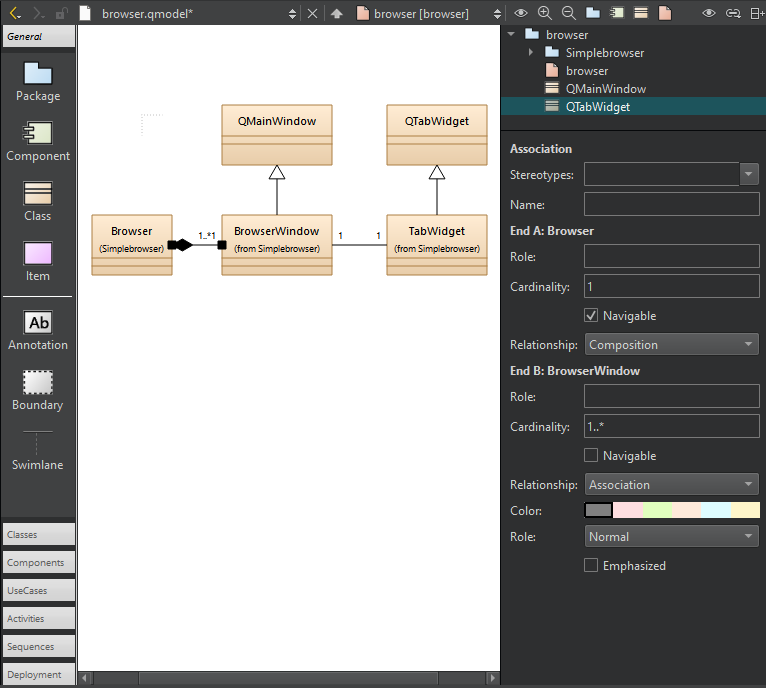Create class diagrams
Create UML-style models that contain class diagrams. They show classes, dependencies, inheritance, associations, aggregation, and composition to visualize a system in an object-oriented way.

A class diagram in the model editor.
To create class diagrams:
- To add C++ classes to class diagrams, drag files from Projects to the editor, and select Add Class.
- In addition to the common element properties, you can specify the following properties:
- In Template, specify the template to use.
- In Template display, select the display format for the template:
- Smart displays the template as Box or Angle brackets, depending on the class properties.
- Box displays the template in a small box with a dotted border in the top right corner of the class icon.
- Angle brackets writes the template in angle brackets behind the class name using the C++ syntax.
- In Members, specify members for the class, as described in Specify members.
- Select Clean Up to format the contents of Members depending on their visibility (private, protected, public) and following the rules set for whitespace, line breaks, and so on.
- Select Show members to show the members in the diagram.
To navigate from a class in a diagram to the source code, double-click the class in the editor or select Show Definition in the context menu.
Add relations
Elements in class diagrams can have the following types of relations:
- Aggregation
- Association
- Composition
- Dependency
- Inheritance
The end points of association relations can have the following properties:
- Cardinality
- Navigable
- Role
- Relationship
Create self-relations
To create self-relations, start creating a new association and press Shift to create a new sampling point while dragging the association. Create another sampling point and drag the association to the same class.
Add and delete points
To add more points, press Shift and click a relation.
To delete a point, press Ctrl and click a point.
Specify members
To specify members for the class, enter each member on a separate line using a C++ like syntax. For example, the following lines define the method m that is private, virtual, and constant:
private: virtual int m(string a) const;
You may group members:
You may add stereotypes to members:
<<setter>> setPosition(const QPointF &pos);
There are some limitations of the parser:
- Multi-line declarations work only if lines are wrapped within nested brackets:
void setSize(int width, int height);
- Preprocessor macros will not be translated. Some Qt keywords are recognized (for example Q_SLOT).
- Function pointer declarations are interpreted as methods.
throw()andnoexpect()specifiers are not ignored but will make the declaration a method.
See also How To: Create Models and Diagrams and Model Editor.
© 2024 The Qt Company Ltd. Documentation contributions included herein are the copyrights of their respective owners. The documentation provided herein is licensed under the terms of the GNU Free Documentation License version 1.3 as published by the Free Software Foundation. Qt and respective logos are trademarks of The Qt Company Ltd in Finland and/or other countries worldwide. All other trademarks are property of their respective owners.
